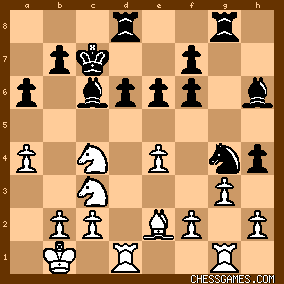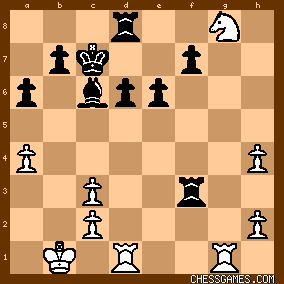YouRang: I think the key move occurred here, on white's 22nd move:

click for larger view
The black knight is attacking Ph2 and Pf2. Should white (a) take the pawn with the bishop (22.Bxg4), or guard the f-pawn with the rook (22.Rgf1)? It seems most simple and natural to eliminate the knight as white did in this game. However, this seems to be the seed of destruction for white. The counter-intuitive 22.Rgf1! keeps the game even, even though the Ph2 is left unguarded. If 22...Nxh2?, then 23.Rh1 Ng4 24.Rxh4 Nxf2 25.Rf1 Bg5 26.Rxf2 Bxh4 gxh4 and if anything, white is better. With best play, it might go: 22...Ne5 23.Rd4 hxg3 24.fxg3 Bg7 25.a5 = But after <22.Bxg4>, black gets the upperhand, as the game continued: <22...Rxg4 23.f3 Rg5 24.Ne3 Rc5 25.Ng4 Bg7 26.gxh4 f5 27.exf5> (27.Ne3 really isn't much better: 27...Bxc3 28.bxc3 Rxc3 29.Rd3 Rxd3 30.cxd3 fxe4 31.fxe4 Rh8 32.Rg7 Rxh4 33.Rxf7 Kb6 34.Re7 Rh3 35.Nc4+ Kc5 36.Rxe6 Rxd3 37.Na5 Rh3 38.Re7 Kd4 39.Nxc6 bxc6 40.Rd7 Kc5 41.Ra7 Rxh2 42.Rxa6 Re2 43.Ra5+ Kb6 44.Ra8 Rxe4 45.Kc2 d5 46.Kb3 Re3+ 47.Kc2 Kc5  ) <27...Bxc3 28.bxc3 Rxf5 29.Nh6 Rf6 30.Ng8 Rxf3> [diagram] ) <27...Bxc3 28.bxc3 Rxf5 29.Nh6 Rf6 30.Ng8 Rxf3> [diagram]

click for larger view
By this time, black's connected passed pawns and active pieces have a decisive advantage over white's awful pawn structure and awkward pieces. | 




